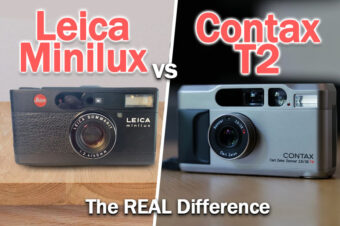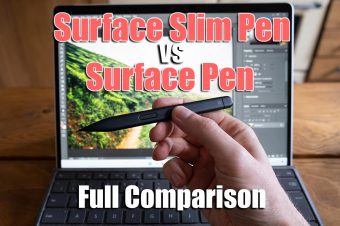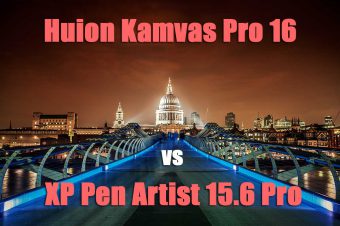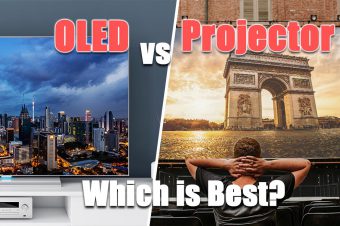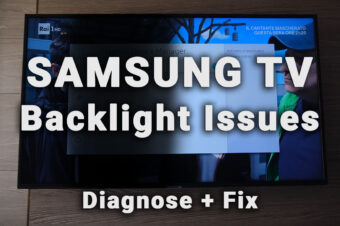This site is part of various affiliate programs. Links may give us a small compensation for any purchases you make, at no additional cost to you. Please read the disclaimer policy for full details.
If you don’t have the time to read the whole article, then when comparing the Contax T2 vs TIX, the Contax TIX is a more advanced camera than the T2 in almost every aspect, and it is significantly cheaper, but it uses a discontinued APS film. The APS film, which will be hard to find, and expired, will substantially increase the cost of using this camera. Due to that, the Contax T2 is a better and more reliable option.
You have probably noticed that, lately, higher-end point-and-shoot film cameras have risen in popularity. Partly because some of them, like the Contax T2, have found their way into the hands of celebrities, partly because many photographers want to experience film photography without too much hassle.
Suppose you have done a little bit of research. In that case, you probably know by now that Contax is one of the higher-end brands of rangefinder and point-and-shoot cameras, often packing a lot of technology and features in compact camera bodies encased with titanium. In other words, they are powerful, luxurious, and good-looking cameras.
So, let’s take a look at two well-engineered Contax point-and-shoot cameras that use different film types: Contax T2 and Contax TIX.
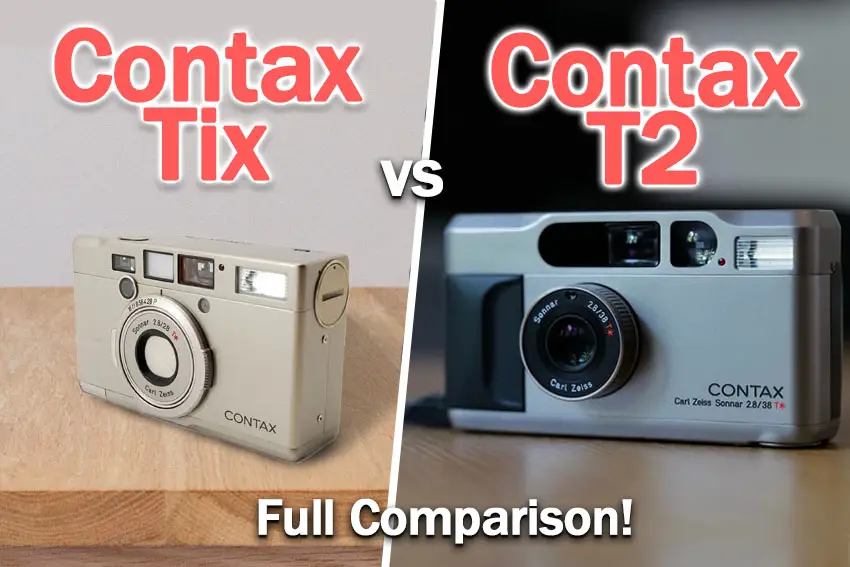
Contax T2 Overview
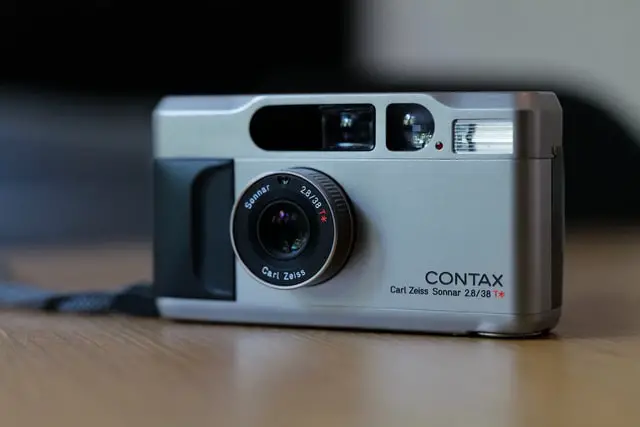
Features:
- Film: 35mm, DX ISO 25-5000, Non-DX Default ISO 100
- Lens: Carl Zeiss T* Sonnar 38mm f/2.8
- Aperture Range: f/2.8 – f/16
- Shutter Speed: 8s – 1/500s
- Exposure Compensation: +/- 2 EV in ½ EV Steps
- Size: 119x66x33mm
- Weight: 296g
Back in the 90s, the high-end market of point-and-shoots was dominated mainly by Leica. Kyocera decided to change that and released the Contax T2. It challenged the Leicas of the time at a lower price, but it was equally well-built and designed. It produced extremely high-quality photos thanks to the Carl Zeiss T* lens.
The Carl Zeiss T* Sonnar lens is 38mm with an aperture of f/2.8. It is incredibly sharp even when wide open, but with a caveat. In aperture priority, you can’t select f/2.8. If in auto mode, the camera selects f/2.8, it reduces the maximum shutter speed to 1/200s.
You will find that the camera can operate entirely automatically, picking every setting for you. You can also use aperture priority and exposure compensation to dial in the exposure by yourself. The metering and autofocus are surprisingly accurate for the time, which is great.
The titanium body makes for a great-looking camera that can handle some rough handling.
Since the camera found itself in the hands of celebrities, the price went up significantly. But as the hype fades away, chances are that the price will return back to normal as well.
- Pros:
- Fantastic looks and retro design that appeals even to celebrities.
- Quite durable due to the titanium build and casing.
- The lens is incredibly sharp.
- You can use it in fully automatic mode or in aperture priority mode.
- Quite expensive.
- Cons:
- You can’t select f/2.8 in aperture priority.
- At f/2.8, the fastest shutter speed reduces to 1/200s.
- Shutter speed and aperture readouts in the viewfinder can be confusing.
Contax TIX Overview
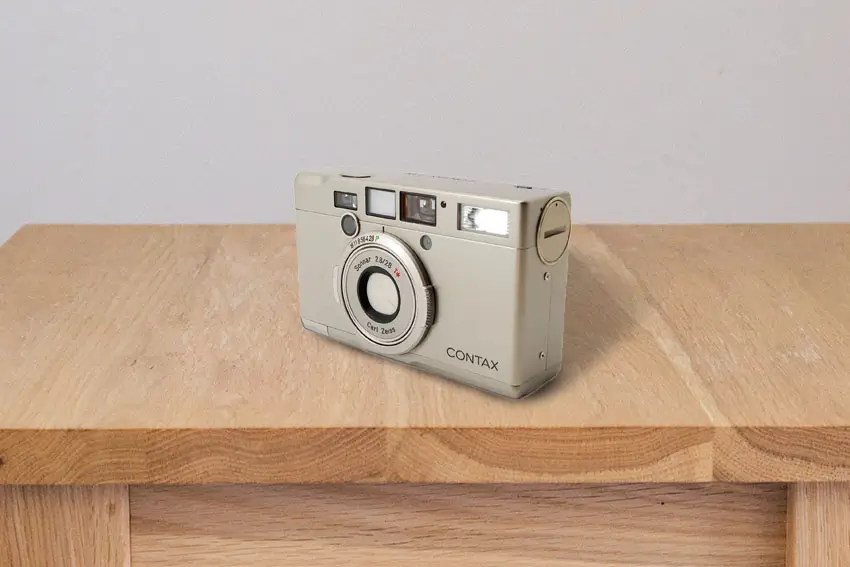
Features:
- Film: IX240 APS format, Automatically Sensing ISO25-10000
- Lens: Carl Zeiss T* Sonnar 28mm f/2.8
- Aperture Range: f/2.8 – f/16
- Shutter Speed: 15s – 1/1000s
- Exposure Compensation: +/- 2 EV in 1/3 EV Steps
- Size: 100×60.5x33mm
- Weight: 225g
As the 2000s approached, it was evident that digital photography was just around the corner and slowly crept into the mainstream. APS format film was an attempt to shrink down the 35mm film cameras by utilizing a smaller film, thus a smaller form factor. Kyocera followed suit and released the Contax TIX.
It is a camera packed to the brim with features, but the APS film was less popular and hindered the sales and popularity of the camera, although this did lead to the incredibly popular APS-C digital sensor, which is in many of today’s best cameras.
Aside from that, the camera featured an excellent Carl Zeiss T* Sonnar lens, sporting a 28mm focal length and f/2.8 aperture. The lens behaves more like 35mm on that film with the crop factor.
Being released in 1997, it has an improved passive autofocus system that can do spot and multi AF, an improved metering system, and built-in data back.
It is a little smaller and lighter than the T2, making it a bit more portable.
- Pros:
- It has a fantastic retro design that will appeal to many.
- Tough and durable due to titanium casing.
- Incredibly sharp Zeiss lens.
- It can work fully automatically or in aperture priority mode.
- Excellent autofocus.
- Quite cheap.
- You can choose from three different aspect ratios for your photos.
- Cons:
- Smaller film, thus smaller prints.
- The film is more challenging to find, and it is often expired.
- Developing APS film properly is even more challenging to do.
Contax T2 vs TIX Comparison
On their own, both cameras look like powerhouses for what they are. However, when you place them side by side, feature by feature, then the differences become more apparent. So let’s do just that.
Lens Quality
Both cameras feature a Carl Zeiss T* Sonnar lens, and both feature an f/2.8 maximum aperture. The Contax TIX has a 28mm lens, while the Contax T2 has a 38mm lens.
At a glance, you’d think that the TIX lens is relatively wider, but remember that the TIX uses smaller film, so the lens actually has a crop factor. If you shoot APS in C mode (classic, retaining a 2:3 aspect ratio), you are looking at a 1.44x crop factor. That makes the lens 40mm, which provides nearly the same field of view as the 38mm on the Contax T2.
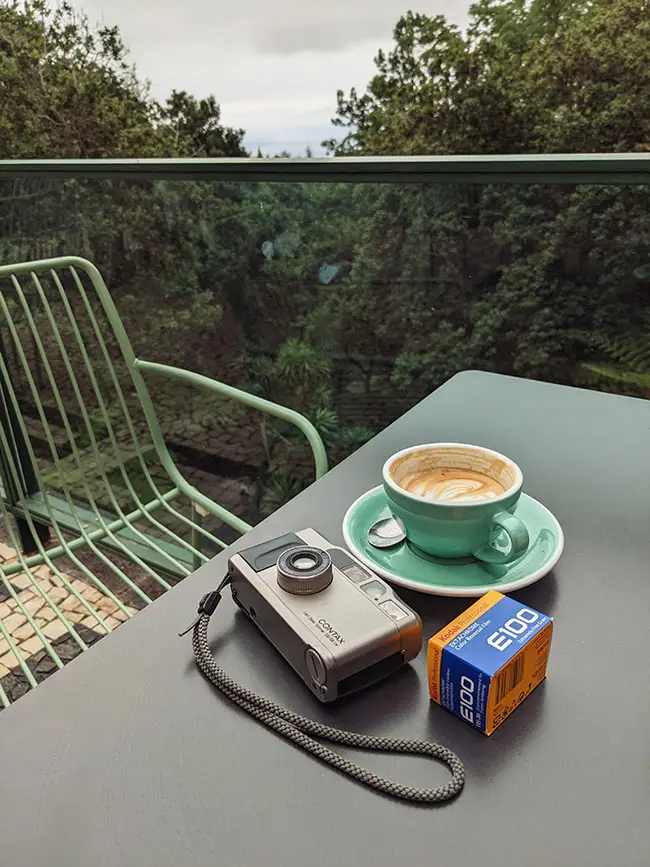
If you decide to shoot at APS-H, that would be a 16:9 aspect ratio, then the TIX has a 1.25x crop, and the lens provides a 35mm field of view. So depending on the aspect ratio, you select, the lens is slightly wider or tighter. But the difference is minimal.
Otherwise, both lenses are incredibly sharp and reproduce colors incredibly well. After all, they both are Carl Zeiss, so optical resolution and optical defects are very well handled in both lenses.
In summary, both cameras have very sharp and very well-corrected lenses. Depending on the picture aspect ratio you select, the Contax TIX lens is 3mm wider or 2mm tighter than the 38mm lens on the Contax T2. In other words, the differences are negligible. On the TIX, you can select f/2.8 in aperture priority, on the T2, you can’t.
Autofocus
Both cameras have autofocus, but the seven-year difference between the TIX and the T2 puts the TIX at an advantage. The autofocus system on the TIX is more advanced and passive, meaning it can handle different situations better.

You have two modes to choose from on the TIX, Spot AF or Multi AF. There is a larger center portion of the frame where the camera can focus, that is Multi AF. If you want more accurate autofocus than that, you can select Spot AF, which will use the center of that center portion. In other words, you can reduce the center Multi AF area to a small spot for accurate focusing.
In short, the TIX has a better autofocus system with two different focus modes. The T2 has a great autofocus system, but it is simply older than the one in the TIX.
Shooting Modes and Usability
As in the Contax point-and-shoot fashion, both cameras can function in full auto mode, where the camera decides about every setting. You can use aperture priority and exposure compensation to control how your photo looks.
However, the T2 can’t select f/2.8 in aperture priority, while the TIX can. Both cameras reduce the maximum shutter speed at f/2.8. The maximum shutter speed of the Contax T2 when using f/2.8 is just 1/200s, while the TIX manages 1/500s.

At f/2.8, the TIX has the same shutter speed as the T2 can achieve in every other aperture besides f/2.8. Overall the TIX can go as fast as 1/1000s, which is excellent for shooting in the high sun.
So, the T2 generally has a slower maximum shutter speed, and you can’t select f/2.8 in aperture priority. Both cameras achieve +/-2EV of exposure compensation.
Style and Design
Both cameras are made from titanium and try to keep a minimalistic and clean design. The TIX looks a bit more minimalistic but also a bit boxy and boring. The T2 has more thought into the design and actually looks like a camera.
Overall, there is a reason why you’ll see the T2 in the hands of celebrities, but you won’t find the TIX anywhere.
Both are tough and can take a beating, and the TIX is slightly smaller and lighter.
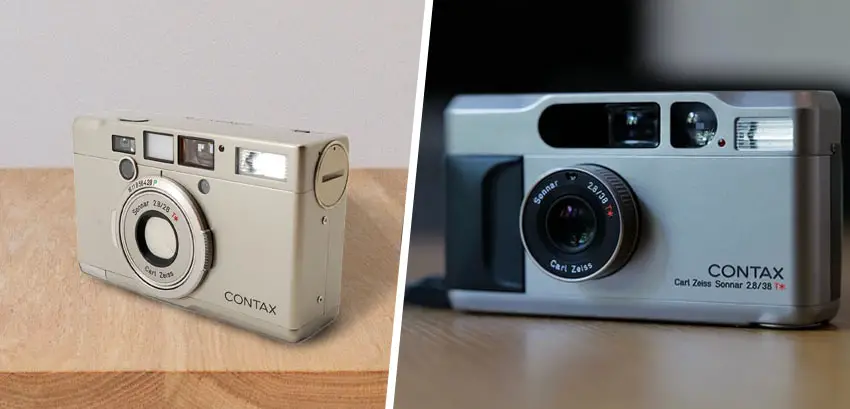
To summarize, the T2 looks better, and the design looks thought out, while the TIX looks like a titanium box with a lens. Both will be tough and made from titanium, but the TIX is lighter and smaller.
Price
The price is where these cameras differ the most.
Due to the celebrity status that the Contax T2 has, a mint condition one will set you back at least $1200. On the other hand, a mint Contax TIX won’t cost you more than $200.
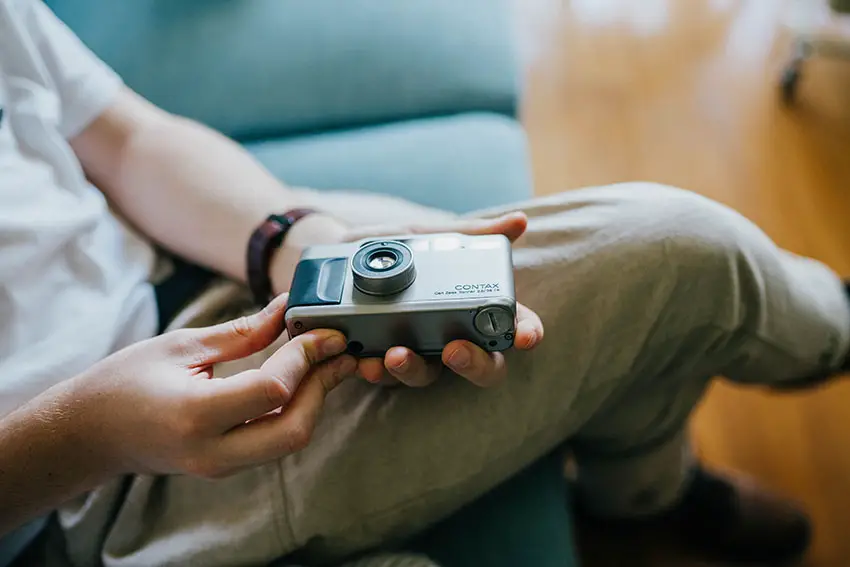
That might seem like an easy decision, but you’ll have to factor film cost, film availability, and film development into the equation here. APS film isn’t that easy to come by, and most of it will be expired. So you’ll have to factor in the cost of use as well.
If you shoot a lot, the TIX will easily make up the upfront cost difference with operating costs, and in the long run, it will cost you more. So have that in mind as well.
Which is the Better Option Between the Contax TIX vs T2?
The Contax TIX has a much better price point and features overall and is not as old as the Contax T2. It might lack in the design department, but it makes up for that in every other aspect.
Well, every other aspect besides the fact that it uses APS film. Being limited to film that is hard to find and expired, film that has fewer exposures per roll, and film that is more complex to develop makes this camera a bit undesirable. Even though it is significantly cheaper, the TIX will cost you a fortune in film and developing costs.
So if you had to pick between these two, and no other camera, the T2 is a better option.


Read More:
